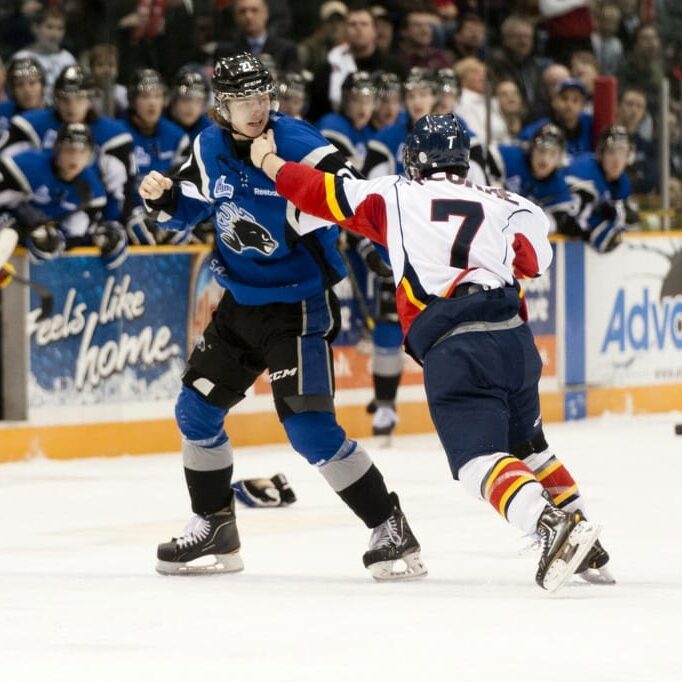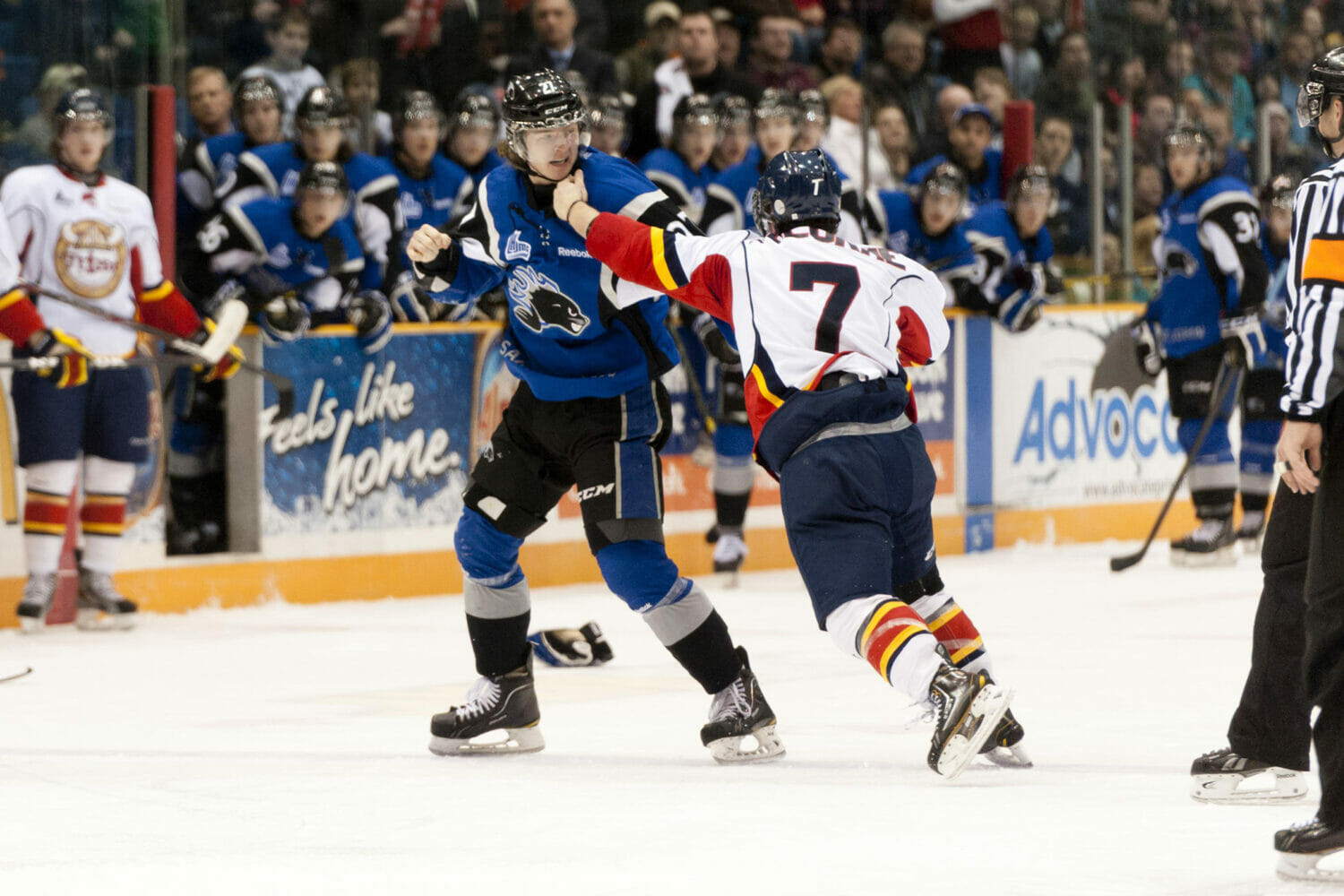

Keep it, scrap it, debate it or accept it: Four writers weigh in on fighting in hockey (photo by Chris Parent)
Unavoidable in today’s game: Josh Fraser, Opinions Contributor
The game of hockey is a collision sport in a low-friction, walled environment. NHL players can clock skating speeds of almost 50 km/h, the average speed of play hovering around 35km/h. Like football, the sanctioned contact can be cataclysmic, and there are four primary officials to ensure the rules are enforced. Unlike football, hockey is a sport on the fly, and especially in today’s game there can be minutes of play between stoppages. As well, penalties cannot be dealt in field position, only in the advantage in number of players for predetermined periods of time. Given the nature of penalties and the sheer speed of the game during which the referees must simultaneously catch every event that occurs, the idea that every nuance can conceivably be caught is silly. This is the condition from which fighting in hockey primarily arises.
Not only must the referee stay out of the way of speedy, unpredictable players, but they must contend with a blurry, crowded surface and often a writhing tangle of arms, legs, and hockey sticks. Teammates on the sidelines will always argue calls for their team, simmering like a mob when indiscretions are carried out behind the backs of officials. These actions, if they persist, elicit retaliations. The officials catch what they can, but when there is an entire dimension to competitive sport that predicates deliberate stretching of the rules in the spirit of physical and psychological warfare, there is no question that most hockey teams have a strong internal sense of justice that remembers indiscretions and violent tactics across matches, often adding fuel to an already steady flame of competition. In this culture of evaluating and distributing justice physically, natural positions on the team arise for tough, fearless players to keep the other team in check. This need not necessarily be a goon, yet it is seldom a gentle giant who fills the enforcer role.
That being said, it is perfectly rational to evaluate the effect of this violence as it is amplified by media and appropriated by aspiring young athletes. Worse, the CBC recently ran a story on minor hockey coaches who awarded five dollars to the perpetrator of the game’s most violent hit. The best thing we can do for hockey culture is demand that coaches be properly trained. In many ways, they should be considered no different than classroom teachers and require similar skill sets as leaders and authority figures. Properly taught to enact and receive physical contact including grey-area roughness, players should be encouraged and mentored to keep a level head, choosing to retaliate within the rules of the game, and to know when not to back down from malicious intimidation.
Trying to prohibit fighting in hockey is like trying to kill a ghost. The fact remains that hockey players are sent to the penalty box, and at times ejected from the game for fighting; it is illegal in the same sense as slashing, spearing, or tripping are all penalties for infractions of the rules.
Quite frankly there are plenty of ways to sustain serious injury without dropping the gloves, and one should not overplay the importance of a face-to-face confrontation in a fast sport of stick-wielding, padded gladiators.
I’m open to changing hockey, but not much can be drastically altered without seriously rethinking the identity of the sport—it’s a paradox of aspiring to physical perfection and paying a high price to win.
Scrap it: Samantha Elmsley, Opinions Editor
I should preface this article by saying that I am not a hockey fan, but there’s a reason for that: I deplore the fighting that almost inevitably breaks out during the games.
There is nothing fun about watching young men and women get the consciousness knocked out of them. It’s supposed to be a hockey match, not a gladiatorial combat: for me, it’s never worth watching a player being taken off the ice on a stretcher for the sake of a game. Call me crazy, but I don’t find human suffering entertaining, especially in the context of something as preventable as a fight during a refereed game.
I find it disturbing that people of all ages think it is acceptable to stand on the benches, screaming their players on as they wrestle each other like children in a schoolyard. What happens when a player becomes seriously injured during such a match? Those spectators become complicit in the injury. It’s not so exciting when someone can’t stand up anymore.
It’s just a game. At the end of the day, sports are for entertainment. In this context, risking serious injury to our players seems too steep a price to pay for cheap thrills. You like gore and violence? Watch the Discovery Channel. That shit gets real in a way that our games shouldn’t.
Maybe?: Benjamin Blum, Sports Editor
The debate about fighting in hockey is best described as a complicated one. Before you dismiss the argument against its removal as boorish and backward, it’s worth taking a closer look.
Those who argue for banning fighting from hockey say that it leads to further injuries and, in a worst-case scenario, death. While the George Parros injury is a sobering example of what could happen in a fight, NHL players are more likely to be injured in the other 59 minutes and 30 seconds of a game from a shoulder to the head, or a slash to the unprotected part of a player’s leg, or, in the case of Sabres goalie Clint Malarchuck, an errant skate blade to the jugular. The last example shows that injuries will occur, intentional or not.
Another argument proposes that it is out of place in the modern game, and that players whose only purpose in the league is to drop the gloves shouldn’t have the chance to hit the ice. While I agree that the “staged bouts” are as real as a WWE fight, there is still a place for enforcers who contribute in multiple ways.
Whether or not fighting is outlawed, there will still be dirty players who take cheap shots at another team’s players, often higher-profile ones. Fighting acts like a nuclear deterrent against these kinds of players to make sure they’re aware that even if the ref doesn’t blow the whistle, someone will clean their clock.
I was raised to believe that fighting is not the way to solve problems, and have personally experienced post-concussion symptoms. However, I also believe there is no issue that is black and white and that can’t be resolved in a heavy-handed (apologies for the pun) manner.
All things considered, I don’t believe there is a simple answer to the fighting question, hence why I remain unsure as to my stance on it—but this will not prevent me (and should not prevent you) from discussing the issue further.
Keep it: Erin McCabe, Opinions Contributor
Okay. I’ll admit I’m relatively new to the world of hockey obsession, but in the couple of years since I’ve started watching, my views on fighting have changed considerably.
I never watched hockey as a kid. Frankly, I hated the sport (gasp!). I couldn’t see the point of watching men on skates shooting a flat, rubber ball into a net with sticks. Whenever anyone asked that divisive question, “Leafs or Habs?,” I’d promptly reply “neither.”
The big turn off was all the violence that inevitably seemed to accompany hockey. For no apparent reason, I’d see players drop their gloves and start having it out with one another. I was disgusted, and wondering why people enjoyed watching this. I always thought fighting was pointless and needlessly brutal.
Now that I’ve grown older (and wiser), I’ve fallen in love with this high-intensity, action-packed game and with this newfound perspective, I do see some value in fighting.
Don’t get me wrong, needless violence is not okay and fighting just for the sake of it still makes me groan. However, I respect teammates needing to stand up for each other. If one team is constantly going after one member of the other, by all means his teammates should defend him.
But let’s face it: there are certain players who shouldn’t even try to fight.
Take Sidney Crosby, for example.
He can’t afford to fight his own battles. It’s the other Penguins dropping the gloves when he gets shoved around—not the captain and top scorer.
(We won’t mention Crosby’s propensity for head injuries.)
It would be impossible to eliminate fighting in hockey even if rules were changed. Animosity between teams is an innate part of the sport and players will unavoidably butt heads. Hopefully though, the new rule requiring players to keep helmets on during their bouts will keep those heads a little safer.






